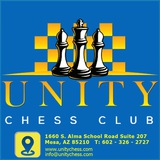34.Rxc2 f5 35.f4 Kf7 36.g4! Rd5 37.gxf5 Rxf5 38.Rd2 Rf6 39.Rd7+ Kg8 40.f5 Rxf5 41.Re7 Nxg7 42.Rxg7+ Kh8 43.Rc7 Kg8 44.Bxc5 Rg5+ 45.Kf2 Rg6 46.Be3
Exploiting his numerical superiority on the queenside, Black sacrifices a pawn to create a passed pawn.
Unable to sustain the pressure of the battle. White could hold a draw by 35.Rc6! c3 36.Be2+ Ka5 37.Rxf6 Bxf6 38.Bd1 Kb4 39.Kf3 Ka3 40.Ke3 Kxa2 41.Kd3 Ka3 42.d6 Kb4 43.d7 a5 44.Bf3 Kc5 45.Bd1 Kb4 46.Bf3 Be7 47.Bd5 f6 48.Bg8 h6 49.g4=.
Unity Chess Club
Bela Toth 2400 Dragoljub Velimirovic 2520 Budva zt 1981 Black to move
If White succeeds in lifting the blockade on d6, his passed pawn will become very strong. He can do this with his knight, for example via d2 to c4. Therefore, Black starts play on the dark squares:
With this move, Black gets rid of an ‘unnecessary’ piece, and not only strengthens his blockading knight, but the whole complex of dark squares. It is important that now the white Bf3 becomes a bad piece, blocked in by its own d5-pawn.
A serious positional mistake, after which White is left with a bad bishop against a beautiful knight. It was essential to decline the exchange, and retreat the bishop to d2 or e3 – in this case, White would retain counterplay, since then Black does not get a free hand for major-piece play on the dark squares.
After an exchange of dark-squared bishops, outposts appear on e5, e3 and g5 – Black happily exploits them.
